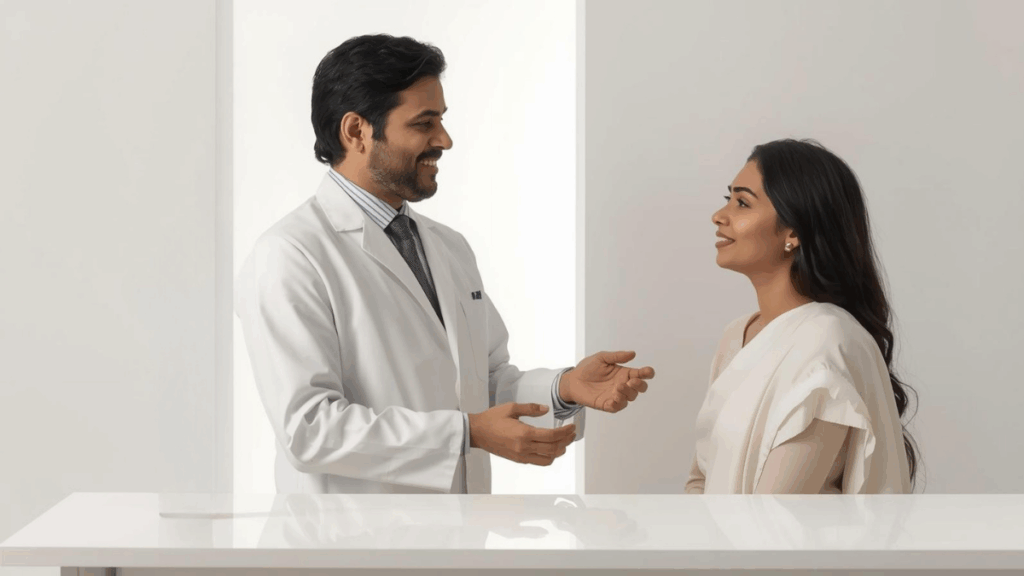Acne is one of the most common skin concerns worldwide, affecting both teenagers and adults. With over 135,000 monthly searches for “acne” in India and growing interest in topical acne treatments such as benzoyl peroxide gel and adapalene gel, dermatologists often recommend combination therapies for better results.
One such trusted topical medication is Clindamycin and Nicotinamide Gel, a dermatologist’s go-to treatment for mild to moderate acne.
What is Clindamycin and Nicotinamide Gel?
Clindamycin and Nicotinamide Gel is a topical formulation that combines two active ingredients:
- Clindamycin – an antibiotic that targets acne-causing bacteria (Cutibacterium acnes).
- Nicotinamide (Vitamin B3) – an anti-inflammatory agent that reduces redness, swelling, and excess oil secretion.
This combination not only kills bacteria but also soothes irritated skin, making it a popular choice among dermatologists for acne-prone skin.

Why Dermatologists Recommend It
Dermatologists prescribe Clindamycin and Nicotinamide Gel because it tackles multiple acne triggers at once. Unlike single-ingredient treatments, this gel provides:
- Antibacterial action against acne-causing bacteria
- Anti-inflammatory relief that reduces swelling and redness
- Sebum regulation to control excess oil
- Prevention of new pimples and breakouts
- Improved skin texture and reduced recurrence with regular use
How Clindamycin and Nicotinamide Gel Works
Acne typically involves clogged pores, bacterial growth, and inflammation. This gel works on all three factors:
- Kills Acne-Causing Bacteria: Clindamycin stops bacterial protein synthesis, reducing infection and pus-filled pimples.
- Controls Oil and Sebum: Nicotinamide regulates sebum production, reducing shiny, oily skin.
- Reduces Redness: Anti-inflammatory properties calm active breakouts.
- Boosts Skin Repair: Nicotinamide strengthens the skin barrier and minimises post-acne redness.
Correct Way to Use It
Proper application is crucial for the best results. Dermatologists recommend the following steps:
- Cleanse: Wash your face with a gentle salicylic acid face wash or mild cleanser.
- Dry: Pat dry gently; avoid rubbing.
- Apply: Use a thin layer of Clindamycin and Nicotinamide Gel only on affected areas.
- Frequency: Apply once daily at night (or as prescribed).
- Sun Protection: Always follow up with sunscreen in the morning.
Dermatologist Tip: Do not layer this gel with strong actives such as benzoyl peroxide, adapalene gel, or tretinoin at the same time unless advised by your doctor.
Side Effects You Should Know
Most patients tolerate Clindamycin and Nicotinamide Gel well. However, mild side effects may appear during the first few weeks:
- Skin dryness
- Mild burning or itching
- Flakiness or peeling
- Rarely, antibiotic resistance occurs with prolonged unsupervised use
If irritation persists, dermatologists may suggest alternating its use or combining it with a soothing moisturiser.
Clindamycin and Nicotinamide Gel vs Other Acne Treatments
| Treatment | Best For | Key Action | Dermatologist Notes |
| Clindamycin + Nicotinamide Gel | Mild to moderate acne | Kills bacteria, reduces inflammation | Safe starter treatment, fewer side effects |
| Benzoyl Peroxide Gel | Inflammatory pimples and pustules | Strong antibacterial and exfoliating action | Effective but may cause dryness or bleaching |
| Adapalene Gel | Blackheads, whiteheads, comedonal acne | Retinoid effect, prevents clogging | Ideal for long-term acne control |
| Azelaic Acid Cream | Pigmentation with acne | Anti-inflammatory and brightening | Helps fade post-acne marks |
| Isotretinoin (oral) | Severe acne | Reduces oil gland activity | Prescription-only, requires strict medical supervision |
When to See a Dermatologist
Clindamycin and Nicotinamide Gel works best for mild to moderate acne. You should consult a dermatologist if:
- Acne is severe, painful, or cystic
- Over-the-counter skincare has not worked after three months
- There are signs of psoriasis or other skin conditions along with acne
- Acne is leaving scars or dark pigmentation
Precautions Before Use
- Not recommended during pregnancy without medical approval
- Avoid applying over eczema, psoriasis patches, or broken skin
- Use cautiously if taking other acne medications such as isotretinoin
- Always perform a patch test before the full application
Best Skincare Routine with Clindamycin and Nicotinamide Gel
Morning Routine:
- Gentle cleanser
- Oil-free moisturiser
- Broad-spectrum sunscreen
Night Routine:
- Cleanser
- Thin layer of Clindamycin and Nicotinamide Gel
- Light moisturiser
Avoid:
- Harsh scrubs
- Alcohol-based toners
- Whitening or bleaching creams
FAQs: Clindamycin and Nicotinamide Gel
1. What is Clindamycin and Nicotinamide Gel used for?
It is mainly used to treat mild to moderate acne, pimples, and breakouts by reducing bacteria and inflammation.
2. Can I use Clindamycin and Nicotinamide Gel daily?
Yes, it is safe for daily use at night unless your dermatologist advises otherwise.
3. How long does it take to see results?
Most people notice improvement within four to six weeks of consistent use.
4. Can I use it with Adapalene Gel?
Yes, but use them at different times of the day or on alternate nights to prevent irritation.
5. Does it help with acne scars?
It reduces redness and inflammation but does not directly fade deep scars. Combining it with azelaic acid or chemical peels may improve results.
6. Is Clindamycin and Nicotinamide Gel safe for oily skin?
Yes, it is particularly effective for oily and acne-prone skin types.
7. Can it be used on the scalp?
Yes, it can be used for scalp acne, but only as directed by a doctor.
8. Is it suitable for teenage acne?
Yes, dermatologists often prescribe it for teenagers experiencing frequent breakouts.
9. What should I avoid while using this gel?
Avoid harsh exfoliants and benzoyl peroxide at the same time, and excessive sun exposure without sunscreen.
10. Do I need a prescription for Clindamycin and Nicotinamide Gel?
Yes, it is a prescription medication and should be used only under medical supervision.
Sources
- Clindamycin topical – Drugs.com
- Nicotinamide topical – DermNet NZ
- Acne: Causes and Treatment – American Academy of Dermatology
- Topical Antibiotics in Acne – Journal of Clinical and Aesthetic Dermatology
- Nicotinamide for Acne – International Journal of Dermatology
- Clindamycin in Acne – Medscape
- Combination Therapy for Acne – Dermatology Times
- Skincare Routine for Acne – Healthline
Medical Disclaimer
This article is intended for educational purposes only and should not be considered medical advice. Always consult a qualified dermatologist or healthcare professional before starting, stopping, or changing any treatment involving Clindamycin and Nicotinamide Gel or any other acne medication.
